 Qualifying for the 2025 US Open starts on Monday 18th August with the first main draw games beginning on the 24th August. For the first part of this article, I will be focusing on pre-match betting, while the second part will discuss some possible trading strategies.
Qualifying for the 2025 US Open starts on Monday 18th August with the first main draw games beginning on the 24th August. For the first part of this article, I will be focusing on pre-match betting, while the second part will discuss some possible trading strategies.
Betting Angles
The good news for tennis punters (rather than traders) is there are plenty of different markets on offer across the multitude of bookmakers. There is the outright win market, which is obviously the most popular, but there is also handicap betting both for games and sets, individual set betting, number of games in a match, first set score, and so on. And some bookmakers offer more niche bets connected with aces or double faults, which player will break serve first, etc.
The problem with betting with bookmakers is the margin, or overround, built into their odds. This is their profit figure basically. Most tennis singles matches where we are wanting to bet one player to beat the other in an outright market, will see an individual bookmaker overround of approximately 5% to 7%. This puts us punters at a disadvantage. Shopping around to get the best prices is a given, or should be, to try to minimise the bookmaker edge.
If you want to play the ‘Set Betting’ market where we’re trying to predict the winner and whether they win two sets to one, or two sets to love, the overround increases to 9% or 10% on average. This market in men’s Grand Slam matches will have 3-0, 3-1 and 3-2 winning options which allows for the overround to nudge up a bit further.
The alternative to traditional bookmakers, as I don’t need to tell anyone reading this, is to bet on the Exchanges. Betfair continues to lead the way, and for betting the outright winner in singles matches prices will generally mirror the very best bookmaker odds available after taking potential commission into account.
There will be more of an edge on the outsider of the pair on Betfair, especially if the favourite is a short price. In terms of the ‘Set Betting’ market, I would say Betfair offers an edge on its competitors especially if it is one of the bigger tournaments. As I am writing this (on August 2nd) there is a fourth-round match in the 1000 WTA Montreal event soon to start between Elena Rybakina and Dayana Yastremska. Currently on Betfair, the Set Betting market overround is just 2.1% as the screenshot below shows:

Of course we need to take potential commission into account, but with most punters paying 2% these days on winning bets, betting this market on Betfair will typically be a better option than using a bookmaker. Liquidity can be an issue though and is the case here with the 2-1 Rybakina scoreline where only £5 is available at the best price of 4.3. Having said that there was £64 available at 4.1 which was still a better price than any bookmaker was offering.
When betting on tennis matches we punters need to be aware that bookmakers do not all have the same rules when it comes to player retirements. There are some bookmakers that don’t pay out on a retirement full stop. This includes Bet Victor, Boyles and William Hill. Hence if you have backed Player A and they are 6-3 5-0 up in a best of three set-match when their opponent retires, your bet is void.
Conversely, if you bet with Betfair, Betfred, Corals, Ladbrokes, Paddy Power or Sky Bet you would still get paid out because these bookies pay out as long as the first set is completed. Retirements occur quite frequently, especially in Grand Slam Men’s singles matches played over five sets. At the US Open since 2020 (five years) there have been 28 retirements in the men’s singles, which equates to 4.4% of all matches.
Let’s now take a look at some of the data from the past five US Opens, focusing on the men’s singles.
Retirements
Let me start by putting a bit more meat on the bone regarding retirements. The graph below shows the percentage of matches per round where there was a retirement. I have grouped Round 4 onwards together as there were only two matches where retirements occurred beyond the third round.
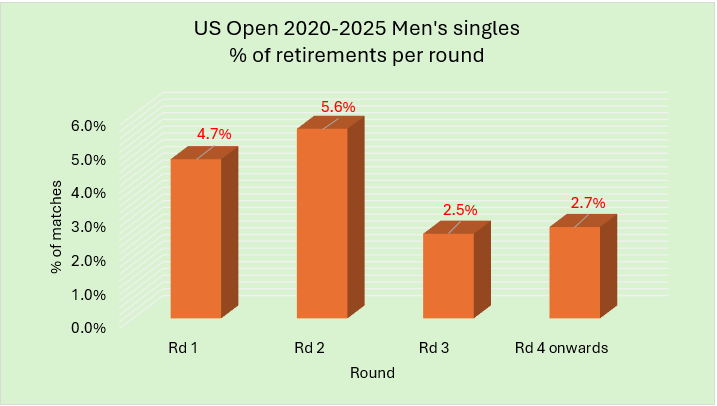
As we can see, the first two rounds have seen a bigger percentage of retirements so that is something to bear in mind. Also, all 28 retirements occurred after the first set was completed so if betting with Bet Victor, Boyles or William Hill your bet would have be voided; with the others, it would not.
I trawled back another five years to see the retirement figures for 2015 to 2019 and a massive 47 players retired during that period.
Hence, at the US Open this year, it will make no real sense to bet with these bookmakers unless you are getting a significant price edge (which is unlikely).
Set Scores
In terms of the winning Set result, what percentage of matches do we think went to five sets? In the past five years in New York the figure is 20.5%. This is based on percentage of completed matches. What about the other set scores? Below is a graph showing the splits for Set results for completed matches since 2020:
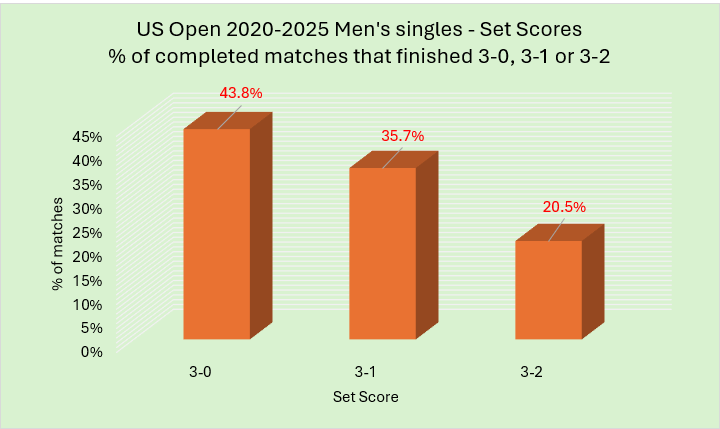
Not surprisingly the 3-0 scoreline has occurred the most, although it is below the average figure for all Slams which is around the 49% mark looking back all the way to 1990. Over the past 35 years, the US Open saw more 3-1 results than any other Slam, and in the last five years this scoreline has occurred around 4% more often than the four-Slam average. For those who decide to play the Set market, then based on past US Open data, the 3-1 scoreline could offer the best value as far as the Set Betting is concerned.
Back the Favourite or the Outsider of two?
Which of the two would have performed best over the last five years of the US Open if betting every player? Well, looking at data for Bet 365, following favourites would have lost 6% of bankroll, while siding with the underdog was worse, at -7.7%.
However, if we look at the best prices across 10 of the main UK bookies, the outsider of the pair has turned out to be the value. Indeed, betting all underdogs at best price would have produced a very small profit of a few quid over around 600 matches; but of course not everyone has accounts at every bookie, nor do many want to bet so unthinkingly.
I suspect backing outsiders on Betfair would have yielded a small profit too, but I don’t have that data unfortunately.
I now want to make a round-by-round analysis of the performance of the favourite to see if there are any patterns. Once again for this section I have included only the matches that were completed, so no matches with retirements or disqualifications are included.

As we can see, the overall win percentage for favourites has been around the 73% mark. The sample sizes start to get a bit smaller once we hit the Quarter-final stage and indeed with two retirements at this point the sample size was slightly smaller than it should have been.
The winning percentage for favourites in the first round is slightly below the overall average which I guess is to be expected. First rounds can provide shock results with lower ranked players having nothing to lose, and higher ranked players perhaps not yet finding their feet. The third-round percentage is the highest for winning favourites, while the Quarter-final percentage is the lowest. I looked back at 2015 to 2019 US Open results for a comparison, and the third-round win percentage was 76% which is a little shy of the more recent mark. Meanwhile the Quarter-final win percentage was low again, even lower at just under 53%.
The data seem to be pointing to the Quarter-final stage as a time to consider backing the outsider of the pair. Indeed, if over the last ten years you had bet the underdog in every Quarter-final match, at best prices, you would have made a profit of £18.26 (ROI +49.4%). However, there is a caveat which is that one QF result provided roughly half of those returns when Dimitrov defeated Federer in 2019.
For favourite backers the last two rounds, namely the Semi-final and the Final, have produced positive returns. From 2020 to 2024 betting the favourite at best prices would have yielded a 9p in the £ return. I thought it prudent to check the results for the previous five years too and profits would have been slightly higher in that period, returning 12p in the £.
Other Scenarios
Before moving onto some 2020-2024 data that might help us when trading matches, there are a few questions I looked into where I want to share my findings.
- What would have happened if we had backed the top eight seeds in an eight-bet accumulator in the first round?
Three of the last five years would have seen a successful eight-bet accumulator. Based on a £10 accumulator each year we would have made a profit of £17.70 (ROI +35.4%).
- What would have happened if we had backed any of the top four seeds in the Semi-final or Final who were playing an opponent seeded fifth or worse?
Eight players seeded in the top four played against opponents seeded fifth or worse and all eight won. Backing them individually using £10 stakes at best prices would have secured a profit of £33.00 (ROI +41.3%).
- Concentrating on Round 1 matches only, what would have happened if we backed all players ranked over 100 in the world assuming they were playing an opponent ranked at least 100 places higher than them?
There would have been 77 qualifiers of which 21 won. Backing them all at best prices would have secured a profit of £108.20 to £10 level stakes (ROI +14.1%).
*
Trading Angles
After Set 1
One of the most popular (and logical) trading strategies is to lay the winner of the first set in a tennis match. In 5-set matches the price movements are going to be less volatile than in 3-set matches, but there is usually going to be a significant shift after set 1 compared with the start of the match. Here are some stats to be aware of based on the last five years of this event.
The winner of the first set went onto lose the second set 38.5% of the time. So nearly four out of every ten matches saw the match go one set all. However, despite this decent percentage it is not high enough to just blindly lay and then trade the first set winner. Digging deeper though, the first set scoreline turns out to be an excellent pointer to the chances of the match being levelled up after the second set. The graph below shows the percentage chance of the match going 1-1 based on the first set scoreline:
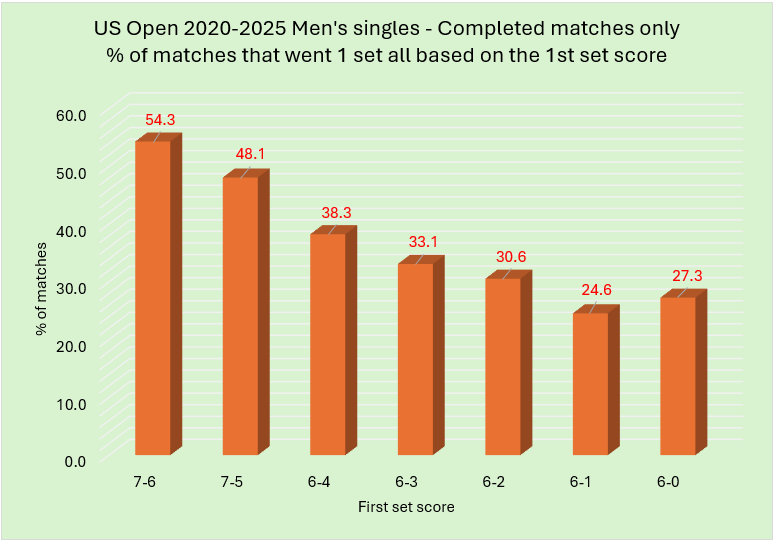
As we can see the graph shows a good correlation in terms of the closer the first set score, the more likely the match is going to go to one set all. In the last five years at the Open, when the first set ended in a tie break (7-6) over 50% of matches have seen the player losing the first set winning the second to level up proceedings. Hence, if you are looking for an entry point, first sets that end 7-6 look a potential starting point. This percentage can be improved a little if we focus on the first three rounds only. Here the percentage hits 57% (58 times from 102 matches).
Another stat about a 7-6 first set to share is when we look at which player won it, in terms of the favourite or the underdog/outsider. We would assume that if the outsider won the first set, then the chances of the match being levelled is going to be higher. Let us see if that is the case:

It certainly has. It seems that if the outsider of the pair wins the first set 7-6, traders potentially have an entry point to lay the first set winner. Of course, there are still many variables to consider with the current prices on offer clearly a key consideration. Each match is different, but traders should have the scope to find some decent trading opportunities with this information to hand.
There is also scope to consider laying the favourite if they have won the first set on a tie-break. Nearly half of the matches have gone 1-1 and the advantage of the laying the pre-match favourite is that the price will be shorter again now, and so with less downside should the favourite go 2-0 up in sets.
Fifth Sets
Finally for this article, let me take a quick look at matches that went to a fifth and deciding set. We saw earlier that around one match in five has gone to five sets since 2020 which equates to 124 matches. My question before digging into the numbers was, ‘at the 2-2 scoreline, what stat is the strongest in terms of predicting the final set winner?’ I thought there were three fairly logical options to consider:
- The winner of the fourth set.
- The pre-match favourite.
- Combining the winner of the fourth set with the pre-match favourite.
The graph below shows the percentage win rate for each:
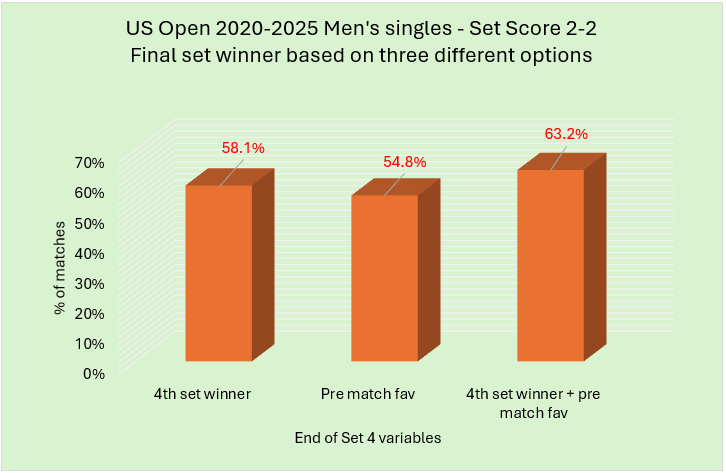
As we can see there does seem to be some momentum going into the fifth set with the fourth set winner winning just over 58% of the time. The pre-match favourite winning percentage figure is lower which may surprise a few people, while combining the two has given us the best chance of finding the eventual match winner (63.2% of matches). For the record I back-checked 2015 to 2019 and the percentage was virtually the same, just a smidge higher at 64.4% of matches.
Taking this into account, I would consider backing the pre-match favourite if they had won the fourth set. Again, there will be other variables to consider before placing our first bet / lay – the price, how each player seems physically and mentally, how well has each player been serving, who is serving first in the final set etc.
The best scenario for our potential selection is for the favourite and fourth set winner to be serving first. If we then decide to place a back bet on the pre-match favourite at the start of the final set, assuming they hold their first service game, there would be a small price swing from the start of the set in our favour that already puts us in the box seat. Another option would be to watch the first couple of games of the set before entering a trade. Unfortunately, there is no right time to enter the market as each match is different. However, the more matches you watch, the more experience is gained, which should help us to make more informed decisions. Tennis Profits members absolutely should take time to watch and learn with/from Paul when he shares his live trades.
The US Open is obviously a great tournament and hopefully we will again be treated to some amazing tennis as well as having opportunities to make some profits along the way.
- DR

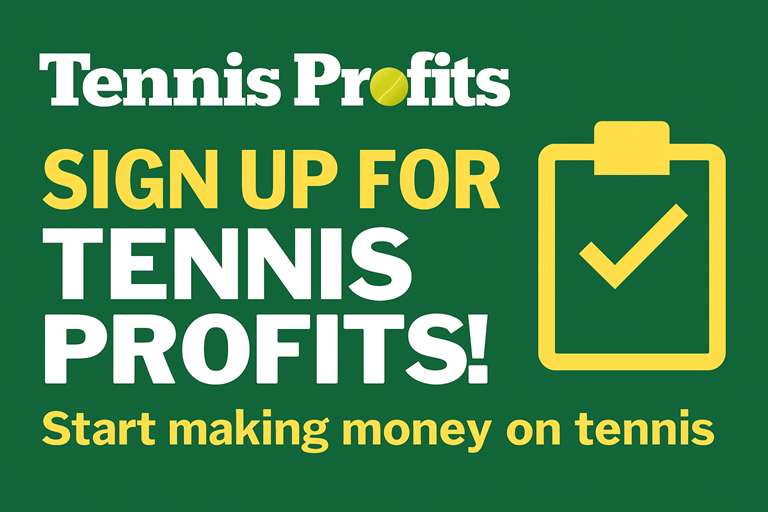

Another fascinating and thought provoking article Dave. Thank you ! Pity I can’t access Betfair at all now from my country thanks to our Government blocking all overseas betting sites, but it doesn’t stop me following and paper trading !
Hi Dave, Thanks for sharing. Can I ask where you pull your data from? I would love to have access to data to test different strategies but always struggle to find anything.
Thanks
Nick
Hi Nick
Apologies for the late reply. Obviously you can get some good stats from this site. Away from here, tennis abstract is a site I use the most. Check it out -it’s got a lot of good stuff on there.
Address is http://www.tennisabstract.com